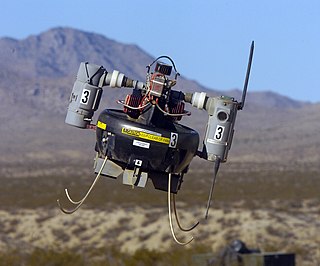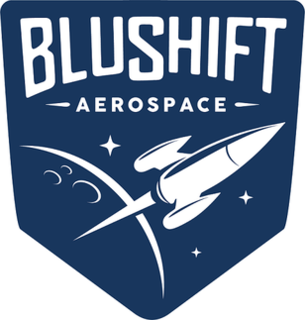
A flying car or roadable aircraft is a type of vehicle which can function both as a personal car or automobile and as an aircraft. As used here, this includes vehicles which drive as motorcycles when on the road. The term "flying car" is also sometimes used to include hovercars.

A jet engine is a type of reaction engine discharging a fast-moving jet that generates thrust by jet propulsion. While this broad definition can include rocket, water jet, and hybrid propulsion, the term jet engine typically refers to an internal combustion airbreathing jet engine such as a turbojet, turbofan, ramjet, or pulse jet. In general, jet engines are internal combustion engines.

The Moller Skycar is a flying car with VTOL capability which has been under development by Paul Moller for over forty years. As of 2022, the M400 has not achieved free flight.

Armadillo Aerospace was an aerospace startup company based in Mesquite, Texas. Its initial goal was to build a crewed suborbital spacecraft capable of space tourism, and it had also stated long-term ambitions of orbital spaceflight. The company was founded by John Carmack, former co-founder and chief technical officer of id Software.
Trek Bicycle Corporation is a bicycle and cycling product manufacturer and distributor under brand names Trek, Electra Bicycle Company, Bontrager, and Diamant Bikes. The company has previously manufactured bikes under the Gary Fisher, LeMond Racing Cycles, Klein, and Villiger Bikes brand names. With its headquarters in Waterloo, Wisconsin, Trek bicycles are marketed through 1,700 independently owned bicycle shops across North America, subsidiaries in Europe, Asia, South Africa, as well as distributors in 90 countries worldwide. Most Trek bicycles are manufactured outside the United States, in countries including the Netherlands, Germany, Taiwan, and China.

A micro air vehicle (MAV), or micro aerial vehicle, is a class of miniature UAVs that has a size restriction and may be autonomous. Modern craft can be as small as 5 centimeters. Development is driven by commercial, research, government, and military purposes; with insect-sized aircraft reportedly expected in the future. The small craft allows remote observation of hazardous environments inaccessible to ground vehicles. MAVs have been built for hobby purposes, such as aerial robotics contests and aerial photography.
Beal Aerospace was a launch vehicle development company founded in February 1997 by Andrew Beal, president of Beal Bank in Dallas, Texas. Headquartered in Frisco, Texas, the goal of the company was to build and operate a privately developed heavy lift orbital launch vehicle. It ceased operations on October 23, 2000.

XCOR Aerospace was an American private spaceflight and rocket engine development company based at the Mojave Air and Space Port in Mojave, California, Midland International Air and Spaceport in Midland, Texas and the Amsterdam area, the Netherlands. XCOR was formed in 1999 by former members of the Rotary Rocket rocket engine development team, and ceased operations in 2017.

The SoloTrek XFV was a single-person VTOL aircraft. It was first flown in December 2001 by Millennium Jet Inc, a private company run by Michael Moshier. Millennium Jet subsequently changed its name to Trek Aerospace Inc. The SoloTrek pilot maintained a standing position and was propelled by two ducted fans located above and on either side of the user, leading some to class it as a type of backpack helicopter. It ran for around 2 hours on gasoline fuel. According to Michael Moshier, its inventor and designer, SoloTrek was capable of hovering for up to two hours, flying at 100 km/h and travelling more than 200 km.

A backpack helicopter is a helicopter motor and rotor and controls assembly that can be strapped to a person's back, so they can walk about on the ground wearing it, and can use it to fly. It uses a harness like a parachute harness and should have a strap between the legs. Some designs may use a ducted fan design to increase upward thrust. Several inventors have tried to make backpack helicopters, with mixed results.
UP Aerospace, Inc. is a private spaceflight corporation headquartered in Denver, Colorado. UP Aerospace provides sub-orbital transportation for corporate, military and educational payloads, via their SpaceLoft XL sounding rocket launch vehicles.

The XCOR Lynx was a proposed suborbital horizontal-takeoff, horizontal-landing (HTHL), rocket-powered spaceplane that was under development by the California-based company XCOR Aerospace to compete in the emerging suborbital spaceflight market. The Lynx was intended to carry one pilot, a ticketed passenger, and/or a payload above 100 kilometres (62 mi) altitude. The concept was under development since 2003, when a two-person suborbital spaceplane was announced under the name Xerus.

A Trekkie or Trekker is a fan of the Star Trek franchise, or of specific television series or films within that franchise.
A gasoline heater is a small gasoline-fueled space-heater. Fixed versions were originally used mainly for supplemental heat for passenger compartments of automobiles and aircraft, with the latter still in production. Portable versions were also made.

The Niagara Aerospace Museum is an aviation museum located in Niagara Falls, New York, in the old terminal building of the Niagara Falls International Airport. The museum has been located in a number of places in the Niagara Falls/Buffalo area. It had been located in the Niagara Office Building in downtown Niagara Falls and relocated in 2008 to the site of the then HSBC center on the waterfront in Buffalo, NY, where it was known as the Ira G. Ross Aerospace Museum. In the summer of 2013, the museum moved to its current location.

The Aerial Reconfigurable Embedded System (ARES) was a concept for an unmanned VTOL flight module that can transport various payloads. The concept started as the TX (Transformer) in 2009 for a terrain-independent transportation system centered on a ground vehicle that could be configured into a VTOL air vehicle and carry four troops. ARES' primary function was the same as TX, to use flight to avoid ground-based transportation threats like ambushes and IEDs for units that don't have helicopters for those missions. It was to be powered by twin tilting ducted fans and have its own power system, fuel, digital flight controls, and remote command-and-control interfaces. The flight module would have different detachable mission modules for specific purposes including cargo delivery, CASEVAC, and ISR. Up to 3,000 lb (1,400 kg) of payload would be carried by a module.

The XTI TriFan 600 is a vertical takeoff and landing aircraft currently under development by XTI Aircraft Company.

BluShift Aerospace is an employee-owned American aerospace firm based in Brunswick, Maine. Targeting the growing smallsat and cubesat launch markets, bluShift is developing suborbital sounding rockets and small-lift orbital rockets which will be launched from a proposed new spaceport in Maine. The company has received primary funding from NASAs SBIR grant program, the National Science Foundations I-Corps grant program, the Maine Technology Institute, and the Maine Space Grant Consortium. The company has active operations at the former Brunswick Naval Air Station and Loring Air Force Base.
CAS Space is a Chinese commercial space launch enterprise founded in 2018 of mixed ownership, partially owned by the Chinese Academy of Sciences. Originally started in Beijing, the enterprise is now headquarterd in Guangzhou, China, while its Beijing location continues to be its primary R&D center. The enterprise has constructed its dedicated launch pad and facilities at JSLC. The launch pad is considered the first launch pad in China built for commercial use. The enterprise has multiple subsidiaries including a Guangzhou-based company responsible for the operation of its aerospace technology & industry base and a Xi'an-based propulsion system company. The enterprise is purposed to materialize research projects from Chinese Academy of Sciences and is dedicated to space exploration, research and to be a launch service provider. The enterprise is currently developing the Zhongke rocket family.













